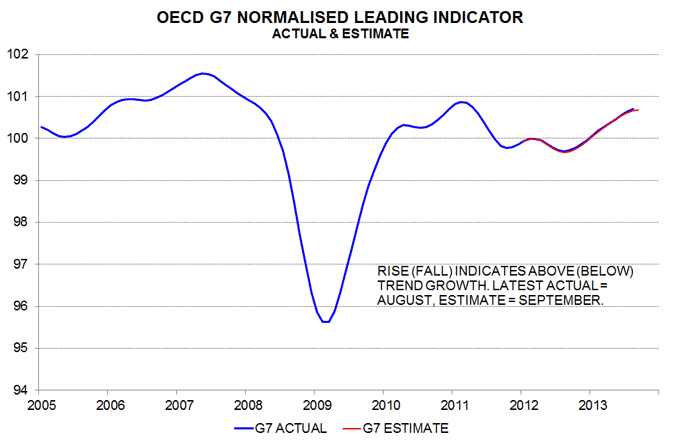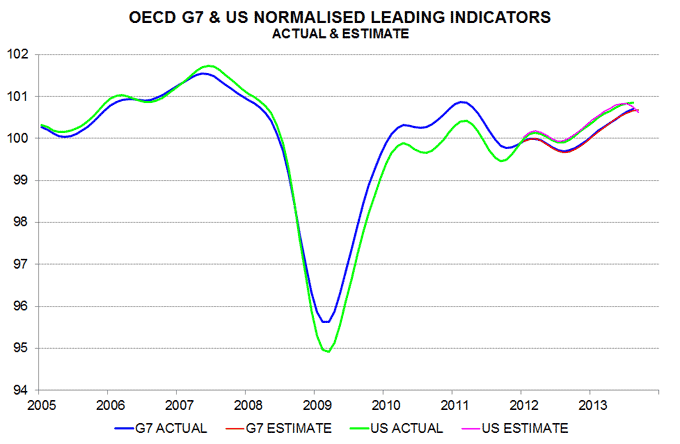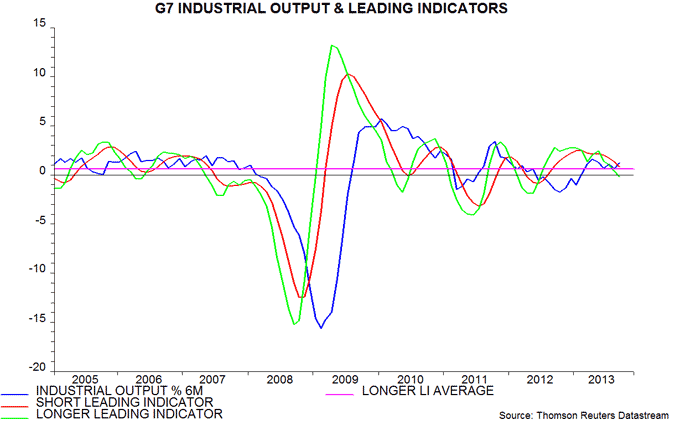Entries from November 1, 2013 - November 30, 2013
Eurozone deflation worries overblown; rate cut irrelevant
The ECB cut its main refinancing rate yesterday supposedly in response to weaker-than-expected inflation news. Current inflation trends, however, reflect monetary policy about two years earlier. The ECB pursued a disastrous policy in 2011, raising rates in April and July even though Eurozone real narrow money M1 was contracting. The consequent recession is the main reason for the recent inflation decline.
ECB policy, however, changed dramatically following Mr Draghi’s installation as President in November 2011. Rate cuts and a series of initiatives to relieve pressure on liquidity-short banks and lower funding costs generally resulted in a strong revival in monetary growth in late 2012 and 2013, laying the foundation for the current economic recovery. Monetary trends have faltered recently – see previous post – but remain consistent with economic expansion and do not support deflation worries.
Importantly, recent lower inflation has not been accompanied by a weakening of consumer and business price expectations – in contrast to the inflation drop associated with the 2008-09 “great recession”. The net percentage of consumers expecting prices to rise at a faster pace over the next 12 months is close to its long-term average and has firmed slightly recently – see chart. This firming is consistent with the change from deflationary to reflationary monetary policy that started two years ago.
Yesterday’s cut in the refinancing rate will have little impact on monetary conditions because short-term market rates were below the new level – the introduction of a negative deposit rate would have been much more significant. President Draghi stated that the ECB is not concerned about deflation, consistent with the assessment above. This raises the question of why it chose to act at all. The probable aim was to cool unwelcome euro strength – the trade-weighted exchange rate has risen by nearly 8% over the last 12 months. It would be surprising if such modest action proved effective and the ECB’s efforts may be thwarted by the Federal Reserve, which remains strongly committed to a weak dollar and may reinforce its commitment to its “low for long” interest rate policy over coming months, as well as delaying “tapering”.
UK "MPC-ometer" close to tightening signal
Four MPC members would be voting to raise Bank rate this week if the Committee were responding to incoming news in the same way as in the past, according to the “MPC-ometer” model followed here.
The MPC-ometer is designed to forecast the “average interest rate vote” of Committee members based on a small number of economic and financial inputs relevant for assessing the outlook for growth and inflation. Estimated in 2006, the model proved useful for predicting interest rate changes in the late 2000s; it also signalled the expansions of QE in 2011 and 2012*.
The model reading for November is +10 basis points (bp), suggesting four votes for a 25 bp Bank rate rise and five for no change**. The reading has risen from a recent low of -9 bp in May, when the MPC was contemplating further easing – three members voted to expand QE every month between February and June.
The further increase in the model reading this month from +5 bp in October reflects robust third-quarter GDP expansion, additional strength in purchasing managers’ surveys, higher consumer inflation expectations and a buoyant stock market.
The judgement here is that the MPC has already fallen “behind the curve” by failing to respond to compelling evidence of monetary excess, such as a surge in annual M1 growth into double-digits. The fact that the MPC-ometer has yet to signal a tightening move is not at odds with this view, since the Committee has kept policy too loose on average historically.
The current position, of course, is unprecedented because the MPC has locked itself into a straitjacket in the form of its “forward guidance” framework. This guarantees that necessary policy restraint will occur even later than in previous cycles, in turn implying another significant inflation overshoot in 2014-15, with subsequent negative consequences for economic growth.
*The model was modified in 2009 to incorporate QE, with the relevant parameter implying that £75 billion of gilt-buying is the policy equivalent of a quarter-point rate cut.
**Such an outcome would imply an average interest rate vote of 11 bp, i.e. four-ninths of 25.
OECD leading indicators may signal global growth peak
The OECD’s leading indicator indices are widely monitored and influence investor perceptions of the state of the global economy. September data to be released next week* may signal a loss of growth momentum; this could cause investors to become more cautious about equity market prospects.
The OECD’s indices are presented in “normalised” form so that a stable reading indicates economic growth at trend. The key G7 index has been rising since late 2012, suggesting future above-trend expansion – the OECD claims that its indicators lead by six to nine months. However, an attempt here to replicate the OECD’s calculations yields an estimate that the G7 indicator stabilised in September – see first chart. If confirmed, this would raise doubts about the current consensus view that global growth will be significantly stronger in 2014 than 2013.
The estimated stabilisation of the G7 indicator in September reflects weakness in the US component – second chart. The latter may be picking up a transitory negative impact from the recent government shutdown and uncertainty about whether the debt ceiling would be raised. This suggests waiting for an October reading released in early December before concluding that US / global growth prospects are deteriorating.
The OECD indices are used here to construct short and longer-term leading indicators of G7 industrial output growth. If the September OECD estimate proves correct, both indicators will decline notably, with the longer-term measure crossing below its historical average – third chart**. Such a crossover would cause the investment rule described in a previous post to switch from equities to cash.
*Tuesday 12 November.
**The last indicator readings in the chart are estimates.



UK consumer recovery is soundly-based and welcome
Having failed to predict the current economic upswing, the commentariat now decries the “wrong kind of growth”. A typical “argument”: consumer credit rose at an annualised rate of 6.0% in the latest three months, while average weekly earnings are up by only 0.7% over the past year; so consumers must now be “releveraging” to finance another spending splurge, even though debt is still at an unsustainable level.
Wrong, wrong, wrong. Consumer credit accounts for only 9% of the stock of household sector borrowing from banks, which is dominated by mortgages. Total borrowing rose by 1.5% annualised over the last three months and is only 1.0% higher than a year ago.
This borrowing rise needs to be compared with total income growth, not the increase in average weekly earnings. Solid expansion in employee numbers coupled with stronger self-employment and entrepreneurial income resulted in non-property-related earnings rising by 4.1% in the year to the second quarter. Borrowing, therefore, continues to grow more slowly than income.
Total household debt was 141% of disposable income at the end of the second quarter versus a 2008 peak of 170% – see chart. A judgement about sustainability should take into account the burden of interest service and the value of assets. Interest payments were 5.6% of income in the second quarter, a low in data extending back to 1987. The interest burden would remain below its post-1987 average of 8.6% even if the average interest rate on debt rose by 2 percentage points. The ratio of debt to wealth, meanwhile, is likely to fall below its post-1987 average of 17.4% in 2013, reflecting house and share price gains and saving.
So borrowing isn’t surging, incomes are growing respectably and debt is consistent with servicing capacity and wealth.
A consumer splurge? The volume of spending in the second quarter was no higher than in the second quarter of 2007. Is six years of stagnation insufficient for the killjoys?


